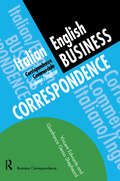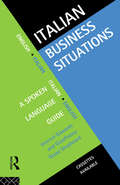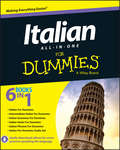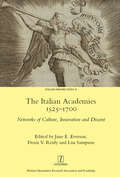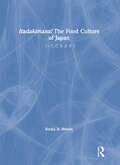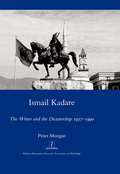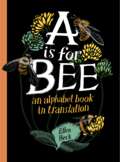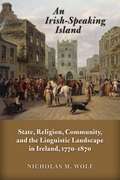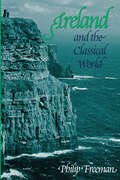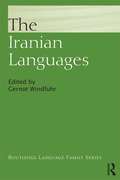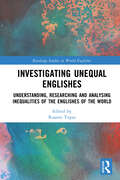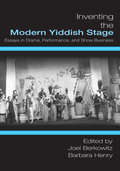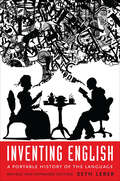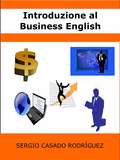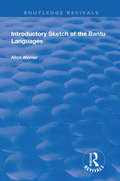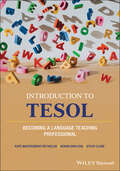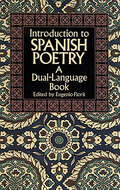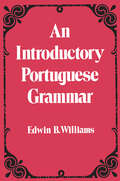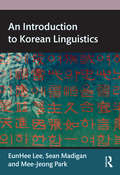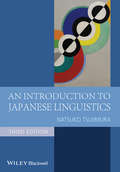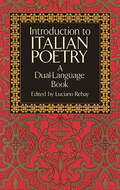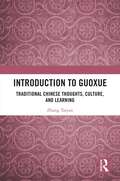- Table View
- List View
Italian/English Business Correspondence (Languages For Business Ser.)
by Vincent Edwards Gianfranca Gessa ShepheardItalian/English Business Correspondence is a handy reference and learning text for all who use written Italian. 80 written communications are simply presented covering memos, letters, faxes and resumes. The situations covered include:*Arranging meetings*Acknowledging orders*Enquiring about products*Applying for jobsWith full English translations, this text is suitable for both students and professionals and can be used for either reference or class use.
Italian Business Situations: A Spoken Language Guide (Business Situations Ser.)
by Vincent Edwards Gianfranca Gessa ShepheardItalian Business Situations is a handy reference and learning text for all who use or need spoken Italian for business.Over 40 situations are simply presented, including* basic phone calls* leaving messages* making presentations* comparing, enquiring, booking* selling techniquesWith full English translations and usage note, Italian Business Situations will help you to communicate confidently and effectively in a broad range of everyday situations.
Italian All-in-One For Dummies
by Consumer DummiesLearn to speak Italian like a native? Easy.Italian All-in-One For Dummies appeals to those readers looking for a comprehensive, all-encompassing guide to mastering the Italian language. It contains content from all For Dummies Italian language instruction titles, including Italian For Dummies, Intermediate Italian For Dummies, Italian Verbs For Dummies, Italian Phrases For Dummies, Italian Grammar For Dummies, and Italian For Dummies Audio Set. Offers readers interested in learning Italian a valuable reference to all aspects of this popular languageThe content appeals to students, travelers, and businesspeople who visit Italian-speaking countriesAn online companion site allows you to download audio tracks allows for more practice opportunities, as well as additional content empowering you to speak Italian like a nativeWhether you're a pure beginner or have some familiarity with the language, Italian All-in-One For Dummies, with downloadable audio practice online, is your ticket to speaking, and writing, Italian.
The Italian Academies 1525-1700: Networks of Culture, Innovation and Dissent (Legenda)
by Jane E. Everson Denis V Reidy Lisa SampsonThe intellectual societies known as Academies played a vital role in the development of culture, and scholarly debate throughout Italy between 1525-1700. They were fundamental in establishing the intellectual networks later defined as the ‘République des Lettres’, and in the dissemination of ideas in early modern Europe, through print, manuscript, oral debate and performance. This volume surveys the social and cultural role of Academies, challenging received ideas and incorporating recent archival findings on individuals, networks and texts. Ranging over Academies in both major and smaller or peripheral centres, these collected studies explore the interrelationships of Academies with other cultural forums. Individual essays examine the fluid nature of academies and their changing relationships to the political authorities; their role in the promotion of literature, the visual arts and theatre; and the diverse membership recorded for many academies, which included scientists, writers, printers, artists, political and religious thinkers, and, unusually, a number of talented women. Contributions by established international scholars together with studies by younger scholars active in this developing field of research map out new perspectives on the dynamic place of the Academies in early modern Italy. The publication results from the research collaboration ‘The Italian Academies 1525-1700: the first intellectual networks of early modern Europe’ funded by the Arts and Humanities Research Council and is edited by the senior investigators.
Itadakimasu! The Food Culture of Japan: いただきます!
by Becky A. BrownItadakimasu! The Food Culture of Japan is designed as a first- or second-year college course in Japanese culture for students who have little to no background in the Japanese language, culture, literature, or history. Unlike any other culture text, Itadakimasu! offers a unique approach to learning about culture through a country’s cuisine. This account takes students on an exciting journey into the world of Japanese food culture, both past and present, exploring themes such as regional specialties, annual festivals, traditional foodways, prominent tea masters, culinary expressions, restaurant menus, dining etiquette, mealtime customs, and culinary aesthetics. Itadakimasu! also addresses current events in the food industry and agribusiness, health and nutrition, dieting trends, fast food, and international and Western influences. Enhancing this wealth of cultural material are autobiographical essays written by guest contributors and varied literary excerpts featuring food themes across different genres in literature spanning many centuries. Each of the readings is supplemented by general comprehension questions followed by more probing queries calling on critical and analytical thinking to methodically guide students from a cursory understanding of a new culture to reflections on their own experiences and other world cultures. Resources also highlight food-centric films so that students can witness what they are learning about in an authentic cultural context. Furthermore, teachers and students alike can enjoy food tasting labs in the classroom, fostering yet another authentic experience for the students. With the intention of reaching a broad audience of students majoring or minoring in Japanese or Asian Studies, or students learning English as a Foreign Language or English for Specific Purposes, Itadakimasu! could also be useful for composition and conversation courses and the Writing Across the Curriculum series or as a supplement for 'Four Skills' Japanese language courses and introductory Japanese literature offerings. Above all, its multifaceted design with a broad spectrum of self-contained sections welcomes individual teaching styles and preferences. Itadakimasu! paints an appetizing image of Japan’s society with just a dash of culture, a pinch of language, and a taste of literature to tempt the palate of students new to the study of Japan. Meant to enhance the regular curriculum, this innovative approach to learning about Japan suggests that the culinary world can lend an insightful view into a country’s culture. Historical and contemporary foodways are universal elements common to all cultures, making the subject matter inherently relatable.
Ismail Kadare: The Writer and the Dictatorship 1957-1990
by Peter MorganIsmail Kadare has experienced a life of controversy. In his own country and internationally he has been both acclaimed as a writer and condemned as a lackey of the Albanian socialist dictatorship. Coming of age after occupation and war, Kadare (b. 1936) belonged to the first generation of new Albanians. In a land where writers were routinely imprisoned, Kadare produced the most brilliant and subversive works to emerge from socialist Eastern Europe. His work brings to an end the century whose literary beginnings were marked by the terror to which Kafka gave his name. The inaugural award of the International Man-Booker Prize for Literature in 2005 marked an important milestone in the global recognition of Kadare. Ironic, multi-layered and imaginative, Kadare's writing is profoundly opposed to ideology. Through critical analysis of a representative selection of Kadare's works, Peter Morgan explains for a wide audience how Kadare survived and wrote in the repressive Albanian Stalinist environment. Peter Morgan is Professor of European Studies at the University of Western Australia.
A Is for Bee: An Alphabet Book in Translation
by Ellen HeckWhat letter does the word bee start with?If you said "B" you're right – in English!But in many, many languages, it actually starts with A.Bee is Anū in Igbo,Aamoo in Ojibwe, Abelha in Portugese.And Arı in Turkish.Come and explore the gorgeous variations in the ways we talk about familiar things, unified and illuminated through Ellen Heck's eye-catching, graphic scratchboard details and hidden letterforms.
An Irish-Speaking Island
by Nicholas M. WolfAfter 1770, Ireland experienced the establishment of modern forms of Irish Catholicism, new engagement by the public with the political process, and the growth of the modern state, represented by new legal and educational systems. An Irish-Speaking Island investigates the role in these developments of the population who spoke Irish in their daily lives#151;whether as a first or second language#151;and links the history of language contact and bilingualism with the broader history of Ireland in the eighteenth and nineteenth centuries. As late as 1840, Ireland had as many as four million Irish speakers#151;a significant proportion of the total population#151;who could be found in every county of the island and in all social classes and religious persuasions. Their impact on the modern history of Ireland and the United Kingdom cannot be captured by a simple conclusion that they became anglicized. Rather, Nicholas M. Wolf explores the complex ways in which the transition from Irish to English placed a premium on adaptive bilingualism and shaped beliefs and behavior in the domestic sphere, religious life, and oral culture within the community. An Irish-Speaking Island will interest not only historians but also scholars of linguistics, folklore, politics, literature, and religion.
Ireland and the Classical World
by Philip FreemanOn the boundary of what the ancient Greeks and Romans considered the habitable world, Ireland was a land of myth and mystery in classical times.<P><P> Classical authors frequently portrayed its people as savages—even as cannibals and devotees of incest—and evinced occasional uncertainty as to the island's shape, size, and actual location. Unlike neighboring Britain, Ireland never knew Roman occupation, yet literary and archaeological evidence prove that Iuverna was more than simply terra incognita in classical antiquity. <P> In this book, Philip Freeman explores the relations between ancient Ireland and the classical world through a comprehensive survey of all Greek and Latin literary sources that mention Ireland. He analyzes passages (given in both the original language and English) from over thirty authors, including Julius Caesar, Strabo, Tacitus, Ptolemy, and St. Jerome. To amplify the literary sources, he also briefly reviews the archaeological and linguistic evidence for contact between Ireland and the Mediterranean world. <P> Freeman's analysis of all these sources reveals that Ireland was known to the Greeks and Romans for hundreds of years and that Mediterranean goods and even travelers found their way to Ireland, while the Irish at least occasionally visited, traded, and raided in Roman lands. Everyone interested in ancient Irish history or Classics, whether scholar or enthusiast, will learn much from this pioneering book.
The Iranian Languages (Routledge Language Family Series)
by Gernot WindfuhrThe Iranian languages form the major eastern branch of the Indo-European group of languages, itself part of the larger Indo-Iranian family. Estimated to have between 150 and 200 million native speakers, the Iranian languages constitute one of the world’s major language families. This comprehensive volume offers a detailed overview of the principle languages which make up this group: Old Iranian, Middle Iranian, and New Iranian. The Iranian Languages is divided into fifteen chapters. The introductory chapters by the editor present a general overview and a detailed discussion of the linguistic typology of Iranian. The individual chapters which follow are written by leading experts in the field. These provide the reader with concise, non-technical descriptions of a range of Iranian languages. Each chapter follows the same pattern and sequence of topics, taking the reader through the significant features not only of phonology and morphology but also of syntax; from phrase level to complex sentences and pragmatics. Ample examples on all levels are provided with detailed annotation for the non-specialist reader. In addition, each chapter covers lexis, sociolinguistic and typological issues, and concludes with annotated sample texts. This unique resource is the ideal companion for undergraduate and postgraduate students of linguistics and language. It will also be of interest to researchers or anyone with an interest in historical linguistics, linguistics anthropology and language development. Gernot Windfuhr is Professor of Iranian Studies at the University of Michigan; he has published widely on Persian and Iranian languages and linguistics and related languages, as well as on other aspects of Iranian culture including Persian literature and Pre-Islamic Iranian religions.
Investigating Unequal Englishes: Understanding, Researching and Analysing Inequalities of the Englishes of the World (Routledge Studies in World Englishes)
by Ruanni TupasRuanni Tupas presents rich insights into the inequalities of Englishes and the ways in which these inequalities shape and impact English and multilingual speakers from around the world.This edited volume gives a critical take on world Englishes, while showcasing for readers the various inequalities in treatment towards the people who speak English differently, as well as the injustice in that treatment. Research methodologies are explored, providing a glimpse into how data are collected and lending a more thorough look into each study and its conclusions. Chapters address the geopolitics of knowledge production in the teaching, learning and use of English, with strong representations from the peripheries of sociolinguistic studies of English. English is constructed as a language which enables socioeconomic mobility which is one factor that increases the importance of research into this issue, and this book enables researchers to widen their methods of research and apply them to their area of study.A valuable text for academic researchers, as well as postgraduate and advanced undergraduate students, to better understand the linguistic, sociopolitical and epistemic inequality in English communication. It also provides readers with alternative perspectives on lingua-cultural pluralism to unpack social inequalities and hierarchies that exist today.
Inventing the Modern Yiddish Stage: Essays in Drama, Performance, and Show Business
by Barbara Henry Joel BerkowitzCollects leading scholars' insight on the plays, production, music, audiences, and political and aesthetic concerns of modern Yiddish theater.
Inventing English: A Portable History of the Language
by Seth LererA history of English from the age of Beowulf to the rap of Eminem, &“written with real authority, enthusiasm and love for our unruly and exquisite language&” (The Washington Post). Many have written about the evolution of grammar, pronunciation, and vocabulary, but only Seth Lerer situates these developments within the larger history of English, America, and literature. This edition of his &“remarkable linguistic investigation&” (Booklist) features a new chapter on the influence of biblical translation and an epilogue on the relationship of English speech to writing. A unique blend of historical and personal narrative, both &“erudite and accessible&” (The Globe and Mail), Inventing English is the surprising tale of a language that is as dynamic as the people to whom it belongs. &“Lerer is not just a scholar; he's also a fan of English—his passion is evident on every page of this examination of how our language came to sound—and look—as it does and how words came to have their current meanings…the book percolates with creative energy and will please anyone intrigued by how our richly variegated language came to be.&”—Publishers Weekly (starred review)
Introduzione al Business English
by Federico Casablanca Sergio Casado RodríguezEbook orientato a tutte quelle persone interessate a perfezionare il proprio inglese e introdursi i una delle sue varianti imprescindibili, l'inglese aziendale o Business English.
Introductory Sketch of the Bantu Languages (Routledge Revivals)
by Alice WernerFirst published in 1919, this volume provides a detailed linguistic breakdown of the Bantu language family of Central and Southern Africa. Its author held in-situ expertise in Nanja, Swahili, Zulu, Giryama and Pokomo. A professor of Swahili and Bantu languages, she was the author of several books on Bantu languages and African peoples. The volume aims to depict the broad principles underlying the structure of the Bantu language family and attempts a classification of those languages. Contemporaneous with the colonization of Tanzania, many of the areas to which this volume was relevant were under British control at the time of publication.
Introduction to TESOL: Becoming a Language Teaching Professional
by Kate Reynolds Kenan Dikilitaş Steve CloseA comprehensive introduction to TESOL for new and future teachers of English, offering a full and detailed view of the process of becoming a language teacher Introduction to TESOL: Becoming a Language Teaching Professional presents an expansive and well-balanced view of both the interdisciplinary knowledgebase and professional opportunities in the field of language teaching. Written to help aspiring TESOL educators understand how to begin their careers, this comprehensive textbook covers both the foundational linguistic elements of TESOL as well as the practical pedagogical aspects of the discipline. Written with the needs of the introductory student in mind, this book delves into the essentials of English as a Second Language (ESL) and English as a Foreign Language (EFL) teaching, covering professional organizations, language acquisition theories, instructional practices, professional development, and more. Readers are provided with clear descriptions of recent research and contemporary practices, numerous illustrations and examples highlighting key material, and engaging real-world vignettes from professionals teaching internationally. Offering a coherent overview and contextualized orientation of the field of TESOL, this guide: Discusses the differences in TESOL approaches in international settings Addresses the current state and potential future of TESOL with a view for new developments in teaching pedagogy and language research Explores the history and development of the field, including the political, social, and cultural decisions made about language teaching and learning Describes the specializations, niches, and subfields within the discipline of TESOL Explains what, how and why TESOL educators need a working understanding of linguistics and second language acquisition theories Outlines the scope of the profession and how to engage in professional organizations to grow in expertise Introduction to TESOL: Becoming a Language Teaching Professional is essential reading for students and educators planning to enter this dynamic and rewarding area of language teaching.
Introduction to Spanish Poetry: A Dual-Language Book (Dover Dual Language Spanish)
by Eugenio FloritFrom the 12th-century Cantar de Mío Cid to the 20th-century poetry of García Lorca, Salinas, and Alberti, this book contains 37 poems by Spain's greatest poets. Selected by Professor Eugenio Florit, the poems are presented in the full original Spanish text, with expert literal English translations on the facing pages. Enjoy the poetic inspiration, imagery, insight, and wisdom of such masters as Lope de Vega, Miguel de Unamuno, Federico García Lorca, Margués de Santillana, Jorge Manrique, Garcilaso de la Vega, Fray Luis de León, San Juan de la Cruz, Francisco de Quevedo y Villegas, Gustavo Adolfo Bécquer, Antonio Machado, Rafael Alberti, Pedro Salinas, and many more. In addition to the poetic texts, Professor Florit has also provided a wealth of biographical and critical commentary, outlining the significance of the poets and their works in the long tradition of Spanish literature. Portraits of the poets are included where available.
Introduction to Portuguese Grammar (Dover Language Guides)
by Edwin B. WilliamsThis book presents the elements of everyday Portuguese, stressing European Portuguese, but also giving information on Brazilian Portuguese. Covering grammatical topics, vocabulary, and practice sentence material, this book is a solid, well-organized approach to Portuguese that anyone interested in the language will find highly useful.Pronunciation is very clearly explained first, and it is followed by twenty-five well-proportioned, progressive lessons that cover all the main points of contemporary grammar: gender, present indicative, formation of plural, agreement and position of adjectives, definite and indefinite article, use of ser and estar, commands, personal pronouns, imperfect indicative, reflexive pronouns and reflexive verbs, present subjunctive, future and imperfect subjunctive, conditional, negatives, infinitive, pluperfect and perfect indicative, and much more. An Appendix gives conjugations of regular verbs, orthographic-changing verbs, radical-changing verbs, and irregular verbs, while a Portuguese-English Vocabulary, an English-Portuguese Vocabulary, and an Index complete the book.This book is suitable for self-study outside of class, for refresher, and for reference. It is particularly useful as a supplement to phrase and conversational study.
An Introduction to Modern Japanese
by Richard Bowring Haruko Ury LaurieThis is the first book in a two-volume intensive one-year introductory course in Japanese, also suitable for those who wish to work at a slower pace. Students who finish this course will have a firm grasp of how the language works and enough knowledge of the writing system to tackle everyday written material with no more than a dictionary. Particular attention is paid to questions of grammar which foreign learners often find difficult, so Book One can also serve as a reference grammar. An Introduction to Modern Japanese uses both spoken and written forms from the outset. There are word lists for each lesson, and a comprehensive vocabulary for the whole course. Book One comprises fifty-two lessons which are accompanied by exercises and word lists in Book Two. The exercises ensure that the student has understood the grammar explained in the relevant lessons and give further practice in reading and recognising characters. Book Two also contains a full vocabulary, Japanese to English and English to Japanese.
An Introduction to Modern Japanese
by Richard Bowring Haruko Ury LaurieThis is the first book in a two-volume intensive one-year introductory course in Japanese, also suitable for those who wish to work at a slower pace. Students who finish this course will have a firm grasp of how the language works and enough knowledge of the writing system to tackle everyday written material with no more than a dictionary. Particular attention is paid to questions of grammar which foreign learners often find difficult, so Book One can also serve as a reference grammar. An Introduction to Modern Japanese uses both spoken and written forms from the outset. There are word lists for each lesson, and a comprehensive vocabulary for the whole course. Book One comprises fifty-two lessons which are accompanied by exercises and word lists in Book Two. The exercises ensure that the student has understood the grammar explained in the relevant lessons and give further practice in reading and recognising characters. Book Two also contains a full vocabulary, Japanese to English and English to Japanese.
An Introduction to Korean Linguistics
by Eunhee Lee Sean Madigan Mee-Jeong ParkAn Introduction to Korean Linguistics is a valuable and comprehensive text for those with an interest in Korean linguistics. This book provides an in-depth introduction to the basics of Korean linguistics, and modern linguistic theory, in an accessible style. It features a step-by-step approach designed to lead the reader through the linguistic make-up of the language, from the basics of its sound system and sentence structure to the semantics of modern spoken Korean. Features include: Detailed chapters covering the core areas in the field of linguistics, including phonetics, phonology, morphology and syntax Clear and accessible explanations which effectively demonstrate the intricacies and subtleties of the Korean language Suggested readings for those interested in expanding their knowledge of a specific topic Exercises designed to complement the factual and analytical issues covered in each chapter A comprehensive glossary of central terms and a companion website offering a wealth of additional materials. Korean is an invaluable language for the study of theoretical and comparative linguistics as it provides important examples and counter-examples to key issues, making An Introduction to Korean Linguistics an essential text for students and professional linguists alike.
An Introduction to Japanese Linguistics (Blackwell Textbooks in Linguistics)
by Natsuko TsujimuraThe third edition of this established textbook has been thoroughly updated and revised. It maintains its broad coverage of topics from phonetics to language variation, and increases its accessibility by incorporating a more descriptive, less theoretical approach. A fully updated new edition of this successful textbook introducing students to a wide range of issues, phenomena, and terminology in Japanese linguistics Includes extensive revisions to the chapters on phonetics, syntax and phonology, and incorporates a less theoretical, more descriptive approach Features the author’s own data, examples and theoretical analyses throughout Offers an original approach by discussing first and/or second language acquisition within each chapter Includes exercises exploring descriptive and theoretical issues and reading lists which introduce students to the research literature, both of which have been updated in this new edition
An Introduction to Japanese Kanji Calligraphy
by Bob Godin Takezaki KuniiThis step-by-step Japanese calligraphy book explains the systems of Japanese language and delves into details of written Japanese characters and techniques of kanji calligraphy.The word calligraphy literally means "beautiful writing." It is an art form that can be found in most civilizations with a written script. Originally developed to stress the importance of culture, religion and philosophy, over time calligraphy in most languages has developed into a purely artistic expression.In Japanese culture, kanji characters from the Japanese writing system are used in calligraphy. An Introduction to Japanese Kanji Calligraphy is an exploration of this Asian art form, and examines how calligraphic poetry developed in Japan. Written by a Japanese shodo master, it is a wonderful introduction to the beautiful art of Japanese calligraphy.Japanese Kanji Calligraphy includes:An introduction to Japanese calligraphy Background information on the modern Japanese language Hiragana and katakana charts An explanation of the tools of calligraphy A guide to correct calligraphy techniques Step-by-step calligraphy instructions An extensive kanji character library
Introduction to Italian Poetry: A Dual-Language Book (Dover Dual Language Italian)
by Luciano RebayThis anthology highlights seven centuries of Italian poetry that will help you learn the language as well. Included are 34 examples of Italian verse in the original with English translations on facing pages. Twenty-one poets are represented, from Saint Francis of Assisi, author of the first memorable Italian lyric, "Cancio delle creature," to Salvatore Quasimodo, winner of the 1959 Nobel Prize for Literature. Also included are works by Dante, Petrarch, Ariosto, Tasso, and Montale, as well as such lesser known but significant poets as Compiuta Donzella and Cavalcanti. There are even important works by Boccaccio and Michelangelo.In addition to full Italian texts with expert literal translations on facing pages, this edition contains a wealth of biographical and critical commentary.
Introduction to Guoxue: Traditional Chinese Thoughts, Culture, and Learning
by Zhang TaiyanThis book is a collection of Zhang Taiyan's lectures on traditional Chinese thoughts, culture, and learning. Zhang Taiyan is known for his role as an active proponent of Guoxue (Chinese learning) in modern China. This title comprises the transcripts of a series of his lectures on Guoxue given in Shanghai between April and June 1922, and serves as an insightful and influential companion to Guoxue. It systematically introduces the research methods of Guoxue and the development and schools of Chinese classical studies, Chinese philosophy, and Chinese literature, and provides a brilliant analysis of representative figures and works from various periods. It also touches on a wide range of topics in Chinese history, philology, paleography, bibliology, and geography. This book provides Guoxue with many new and thought-provoking ideas and plays a crucial role in the dissemination of Guoxue throughout the world. This title will be essential reading for students and scholars of Sinology and Chinese Studies, as well as for the general public interested in traditional Chinese culture.
